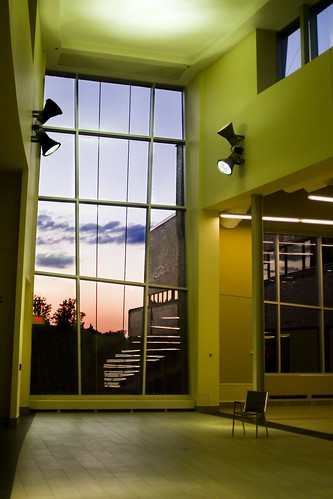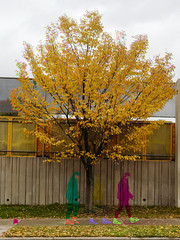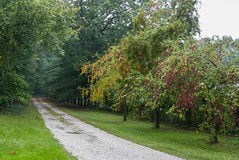The new U
Ian Blum

I saw this walking out of my night class on The Biology of Brain and Behaviour. The light reflecting off the open architecture, setting sun, and lone chair passed through my cornea and projected onto my retinas. My cones then converted these photons into chemical energy which excited my ganglion cells. These in turn caused action potentials that traveled down my two optic nerves to converge, and cross, at the optic chiasm. The right side of the scene traveled to my left occipital lobe and the left side of the scene traveled to my right occipital lobe. This information then projected through the laternal geniculate nuclei and onto my primary visual cortex.
Once a conscious image was formed the electrical signals quickly spread along two separate pathways. The ventral stream leading to the temporal lobe allowed me to recognize the colour of the sunset, name the building, and decide the funny thing with four legs was called a chair. The dorsal stream leading to the parietal lobe allowed me to perceive the motion of the clouds, interpret the motion of my own body, and walk over to pick up the chair. Placing it like it is seen here.
After integrating all of this information yet another set of signals reached my prefrontal cortex where I began planning the shot. Once I had a firm idea of how I wanted it to look this information traveled back along the top of my head through the premotor cortex, which sequenced my actions, and then moved on to the primary motor cotex. This resulted in me removing my camera from my bag, removing the lens cap, turning on my camera, focusing and composing this shot, taking a meter reading, adjusting the aperature, then depressing the shutter. Of course it takes both hemispheres to do this, the right to control my left hand and the left to control my right hand.
The information processing required to take this shot (in an oversimplified manner described above) takes me three paragraphs to describe, over six minutes to compose and type, and about three minutes to edit. Here’s the real kicker; it only takes thirty seconds to perform. We use many words to describe the human brain, all of which are a byproduct of having such an unusually large one, but maybe the most appropriate adjective ever used is simply:
MAGICAL.
View Project:




